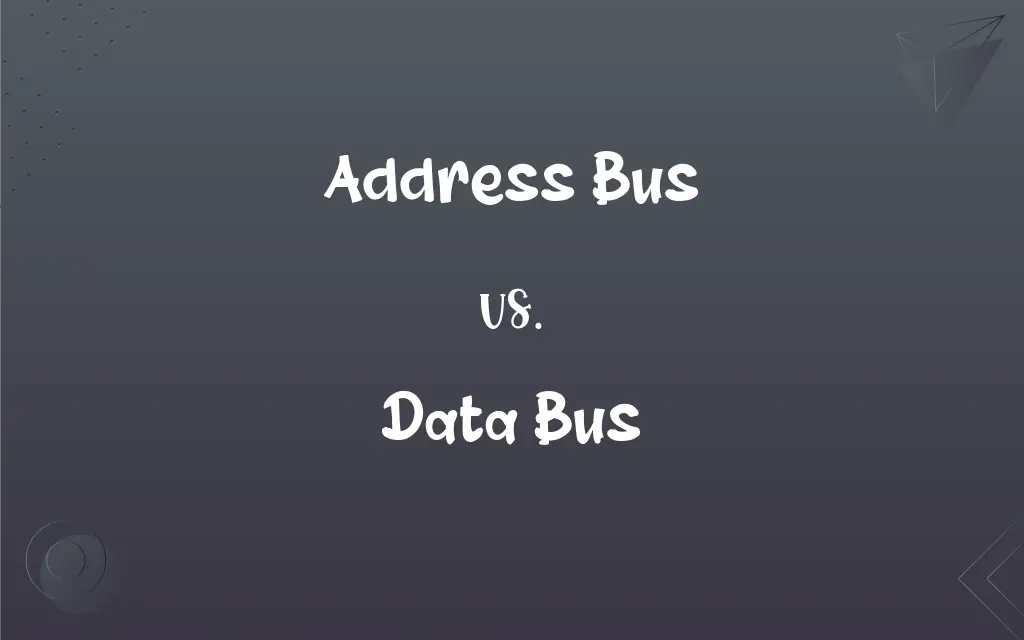Address Bus vs. Data Bus: What's the Difference?
Edited by Aimie Carlson || By Harlon Moss || Updated on October 5, 2023
Address Bus is used to specify a physical address in memory, while Data Bus is used to transport data between the processor and the memory.

Key Differences
In a computing context, the Address Bus and Data Bus serve as two distinct pathways within a computer's central processing unit (CPU). The Address Bus is essentially a conduit used by the CPU to send information about where data should be sent or retrieved in memory. On the contrary, the Data Bus performs the task of actually transmitting the data between the processor and the memory. Each of these buses contributes to how a computer processes and handles information, albeit in divergent manners.
Address Bus and Data Bus, while both essential to the functioning of a computer, have different bit widths. The width of the Address Bus determines how much memory a system can address. For instance, a 32-bit Address Bus allows the CPU to address 2^32 memory locations. Whereas, the width of the Data Bus determines how much data can be sent to or received from memory at once, influencing the overall data transfer rate.
When considering the role of the Address Bus and Data Bus within a system, one can envisage them as two crucial components of a bustling city's infrastructure. Imagine the Address Bus as the system of addresses that helps in pinpointing exact locations (memory locations, in this case). On the other hand, the Data Bus can be thought of as the highways that facilitate the transport (data) to and from those specified locations.
Technological advancements have influenced the evolution of Address Bus and Data Bus architectures. The Address Bus has been subject to increases in width over time, expanding the maximum amount of memory a system can address. Similarly, developments in technology have seen expansions in Data Bus widths, enabling faster and more efficient data transfer between the CPU and memory.
Address Bus and Data Bus reliability is pivotal in the operational effectiveness of a computer. A malfunction or error in the Address Bus could result in data being sent to or retrieved from incorrect memory locations. In contrast, issues with the Data Bus could lead to problems with data transmission, such as corruption or incomplete data transfer.
ADVERTISEMENT
Comparison Chart
Function
Directs data to a memory address
Transports actual data
Width
Determines addressable memory
Affects data transfer rate
Role in CPU
Points to memory locations
Facilitates data transmission
Relation to Memory
Used for addressing memory
Used for data transfer
Impact on Performance
Affects memory access speed
Influences data throughput
ADVERTISEMENT
Address Bus and Data Bus Definitions
Address Bus
Its width is measured in bits and reflects addressing capacity.
A 16-bit Address Bus can access 2^16 memory locations.
Data Bus
A pathway enabling data transfer between the CPU and memory.
The Data Bus carries information from the CPU to be stored in RAM.
Address Bus
A conduit for directing data to specific memory locations.
The Address Bus ensures data reaches the correct RAM slot.
Data Bus
Facilitates bidirectional data flow, allowing for read and write operations.
Data is read from and written to memory using the Data Bus.
Address Bus
Functions independently of the Data Bus while coordinating for data management.
The Address Bus, while pointing to memory locations, doesn’t carry data like the Data Bus.
Data Bus
Engages in transferring actual data as opposed to specifying locations like the Address Bus.
Unlike the Address Bus, the Data Bus physically moves data to and from memory.
Address Bus
Dictates the range of addressable memory within a system.
A wider Address Bus enables access to more memory locations.
Data Bus
Its efficiency impacts the overall speed of data transmission within the system.
The system experiences faster processing when the Data Bus swiftly transfers data.
Address Bus
Utilized by the CPU to specify where data should be retrieved or stored.
The CPU uses the Address Bus to determine where to store the recently processed data.
Data Bus
The width, in bits, determines its data transfer capabilities.
A wider Data Bus allows for the transfer of larger data chunks per cycle.
FAQs
How does the Data Bus contribute to data transfer?
The Data Bus transports actual data between the CPU and the memory.
How is the Data Bus width related to system performance?
A wider Data Bus can transfer more data simultaneously, typically enhancing system data processing speed.
Can the Address Bus or Data Bus be upgraded independently of each other?
Typically, the Address Bus and Data Bus are integral to the CPU architecture and are not independently upgradeable without replacing the entire CPU or motherboard.
Can the width of the Data Bus affect power consumption?
Yes, generally, a wider Data Bus can consume more power during data transfers due to the increased number of active lines.
How does the performance of the Address Bus and Data Bus affect overall system performance?
Effective performance of both the Address Bus and Data Bus is crucial for speedy data retrieval and transfer, significantly impacting overall system performance and efficiency.
What is the primary function of the Address Bus?
The Address Bus is responsible for specifying memory addresses where data should be read from or written to.
What determines the size of data chunks that the Data Bus can transfer?
The width of the Data Bus, measured in bits, determines the size of the data chunks that can be transferred at once.
Are Address Bus and Data Bus widths standardized across all types of processors?
No, Address Bus and Data Bus widths can vary widely across different processors and computer architectures.
Can the Data Bus function if the Address Bus is malfunctioning?
No, without the Address Bus providing accurate memory addresses, the Data Bus cannot correctly transfer data to or from specific locations.
Does a system utilize multiple Address Buses and Data Buses?
A system typically utilizes one Address Bus and one Data Bus, but architectures can vary, especially in more advanced or specialized computing systems.
How does the Data Bus manage simultaneous read and write operations?
Data Buses in modern computers often support simultaneous read and write operations through separate lines or utilizing dual data rate technology.
Why is the Address Bus unidirectional?
The Address Bus is unidirectional because it only needs to send memory addresses from the CPU to the memory, not the other way around.
Is the speed of the Address Bus and Data Bus always synchronous?
Not necessarily, the speeds of the Address Bus and Data Bus can be different and are determined by the system’s design and requirements.
How is data security managed on the Data Bus?
Various protocols and architectures, like data encryption, can be implemented to secure data traveling on the Data Bus.
What happens if there is an error or fault in the Address Bus?
Errors in the Address Bus can lead to incorrect memory addressing, possibly resulting in data corruption or system crashes.
Does a wider Address Bus indicate more memory capacity?
Yes, a wider Address Bus allows the system to access a larger range of memory addresses.
How does the Address Bus impact the maximum RAM a system can support?
The width of the Address Bus determines the range of addresses available, impacting the maximum amount of addressable RAM.
What role does the Address Bus play in cache memory operations?
The Address Bus helps to locate data in the main memory which can then be stored in the cache for quicker access by the CPU.
Can the Address Bus and Data Bus function interchangeably?
No, the Address Bus is strictly for identifying memory locations while the Data Bus moves the actual data.
How is data integrity maintained on the Data Bus?
Error-checking techniques, like parity checks, are often used on the Data Bus to ensure data integrity during transfers.
About Author
Written by
Harlon MossHarlon is a seasoned quality moderator and accomplished content writer for Difference Wiki. An alumnus of the prestigious University of California, he earned his degree in Computer Science. Leveraging his academic background, Harlon brings a meticulous and informed perspective to his work, ensuring content accuracy and excellence.
Edited by
Aimie CarlsonAimie Carlson, holding a master's degree in English literature, is a fervent English language enthusiast. She lends her writing talents to Difference Wiki, a prominent website that specializes in comparisons, offering readers insightful analyses that both captivate and inform.
































































